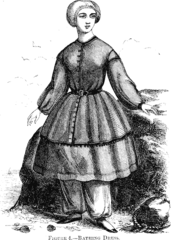
Before people started going to the beach, there was Sea Bathing for health, of course. In 1753 Dr. Richard Russell published The Use of Sea Water, a treatise recommending sea water as a cure for various diseases. The salty water was recommended as an immersive cure and a healing tonic. Russell’s book remained in print until 1846.
While we think of beach vacations as a summer activity, advocates of the sea water cure believed winter was the best time for full immersion in the chilly waves. No doubt a dip in the North Sea in November had a bracing effect.
In the 18th century members of the English middle and upper classes traveled to seaside towns for their health. Naturally, travelers didn’t spend all their time in the ocean. They needed accommodation and entertainment. Old seaside towns like Scarborough were transformed; new ones were born, and the fashion industry developed bathing costumes. Jane Austin recorded events in Sanditon, her last novel, sadly unfinished.
As early as 1737, the City of Bath had a dress code for female visitors to the spa waters:
No Female person shall at any time hereafter go into a Bath or Baths within this City by day or by night without a decent Shift on their bodies.

Sea bathing was another matter. Men and women bathed in separate areas, but women’s modesty required more. By the end of the century, women were wearing bathing gowns in the water. These garments were designed to avoid any transparency when wet, and had weights sewn into the hem to prevent the gown from rising upward in the water. However, many still thought this was insufficient protection for a lady’s modesty.
To remedy this threat, bathing machines became common. A lady entered the machine, which was really a wagon, and changed into her bathing gown. The female dipper kept her lady from slipping, and made sure she had the medically advised three complete immersions.
Meanwhile, men most commonly swam nude, until the practice was banned in 1860. Men’s bathing costumes were knee length trousers with a long top.

The first sea bathing resorts were at Whitby and Scarborough in North Yorkshire before shifting south to Brighton and Weymouth. In particular, Brighton benefited from the Prince Regent’s patronage in the early 19th century.
As the 19th century progressed, sea bathing became more egalitarian. Railway routes developed in the 1840s offered inexpensive fares to seaside towns. Blackpool developed as a resort for the working class on their annual factory holiday week. Blackpool and other seaside resorts provided amusements and entertainment to keep people as happy on the shore as they were taking a dip. The exuberance comes through in the 1907 music hall song: I Do Like to be Beside the Seaside. Sing along, if you like

By the early 20th century, the fashion of women’s bathing costumes changed to a double suit. This was a belted gown from the shoulder to the knees with a pair of ankle length trousers underneath. The costumes were made from heavy flannel. Good for modesty, but not swimming. Women also covered their hair with caps.

Modesty by the beach was an ongoing problem. In 1919, a year after World War I, but before the first flapper appeared, Rockaway Beach in New York employed Sheriffettes to be sure women’s arms and legs weren’t overly exposed.
In 1921, a policeman in Atlantic City arrested a female bather, because she rolled her stockings below her knees and refused to pull them up. She punched the officer.
Despite the “fashion police,” American women flocked to the beach, giving rise to the 1914 song By the Beautiful Sea that topped music charts for six weeks.
🏊🏻♀️🏊🏼♂️🏊🏼♂️
Illustrations
Bathing Machine Gals.
Mermaids at Brighton by William Heath, 1829.
“Don’t Be Afraid.” c.1910.
Bathing Suit, 1858.
Measuring Bathing Suits.
John K. Walton. “The Seaside Resort: A British Cultural Export.” History in Focus.
Chris Wild. “1920s The Swimwear Police.” Mashable.

Sandra Wagner-Wright holds the doctoral degree in history and taught women’s and global history at the University of Hawai`i. Sandra travels for her research, most recently to Salem, Massachusetts, the setting of her new Salem Stories series. She also enjoys traveling for new experiences. Recent trips include Antarctica and a river cruise on the Rhine from Amsterdam to Basel.
Sandra particularly likes writing about strong women who make a difference. She lives in Hilo, Hawai`i with her family and writes a blog relating to history, travel, and the idiosyncrasies of life.

